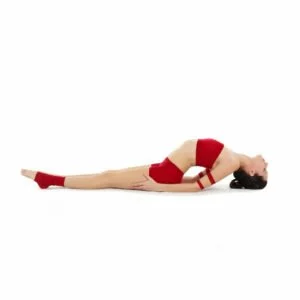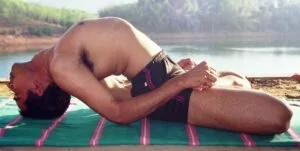 Matsyasana (mahtz-yah-sah-nah; Sanskrit: मत्स्यासन; IAST: Matsyāsana) or Fish Pose is an asana.
Matsyasana (mahtz-yah-sah-nah; Sanskrit: मत्स्यासन; IAST: Matsyāsana) or Fish Pose is an asana.
It is commonly considered a counter asana to Sarvangasana, or shoulder stand, specifically within the context of the Ashtanga Vinyasa Yoga Primary Series
The name comes from the Sanskrit words Matsya (मत्स्य) meaning “fish” and asana (आसन) meaning “posture” or “seat”.
The asana is a backbend, where the practitioner lies on his or her back and lifts the heart (Anahata) chakra by rising up on the elbows and drawing the shoulders back. The neck is lengthened, and the crown of the head Sahasrara chakra is “pointed” toward the ‘wall’ behind the practitioner. As the arch of the back deepens with practice, and the heart and throat open further, the top of the head may brush the ground, but no weight should rest upon it.
How to perform Matsyasana:
- Lie in Samasthiti on the floor. Now bend your knees and bring your legs and feet into Padmasana. Lay your legs back down to the floor while you keep your back on the floor, too.
- Press your elbows, lower arms, and hands to the floor and raise your torso up so that you can place the crown of your head on the floor. This enables you to see behind you.
- Now bring your arms in front of your chest into the Namaste position. Hold the position for 20 to 30 seconds.
- To come out of the pose, first, place your hands and elbows on the floor and then slowly lift your head, lay your back down on the floor and in the end stretch your legs again.
- This is how the traditional Matsyasana is explained in the scriptures, but there are modifications that can be done to make it easier.
- If you cannot perform Padmasana, you can also keep your legs straight. Or you could perform Padmasana as much you can, for example, cross your legs.
- If you feel too much pressure on your head when its crown is on the floor and your hands up in front of your chest, you can also keep your hands on the floor. Do not however place your hands under your hips. If you do, you put the complete weight and work of this exercise to your arms, which is not its purpose.

Benefits of Matsyasana:
-
- This yoga pose directly works with your complete back, from your neck down to your hips. You bring movement into your spine and shoulders which improves your posture and which can reduce back pain. You stretch your neck muscles and your back muscles in a way that you don’t do in your daily routine.
- Matsyasana does not only work with your back but also with your front. Your abdominal muscles get a good stretch and you thus give room to your abdominal organs and intestines. By this movement, you can even help constipation problems.
- Women can do this yoga pose in order to relieve menstrual pain. Matsyasana strengthens the muscles around your reproductive organs and increases the blood flow. This helps to increase the fertility of men and women.
- By bending back your head, you stimulate and activate your throat chakra, the Vishuddhi Chakra.
- At the same time, your respiratory system is getting stretched and you thus help your body to take in more oxygen. If you suffer from Asthma, this pose can give you relieve, as it opens the lungs and increases their capacity.
- The whole area is stimulated and thus the thyroid gland and your pineal and adrenal glands are activated, too.
- You open your chest when you are in this pose and blood is pumped properly through the body.
- Additionally, you tone and strengthen your pelvic area and flex your hips, especially when doing it in Padmasana.
- Through the enhanced blood flow to the head and brain, fatigue, tiredness and the feeling of being lazy can vanish through this pose. You get new energy!

Variations:-
- The legs can be kept straight on the ground with toes pointed.
- The legs again straight can be lifted about 6 inches off the ground with toes pointed.
- The hands may also be placed before the heart in Añjali Mudrā.
